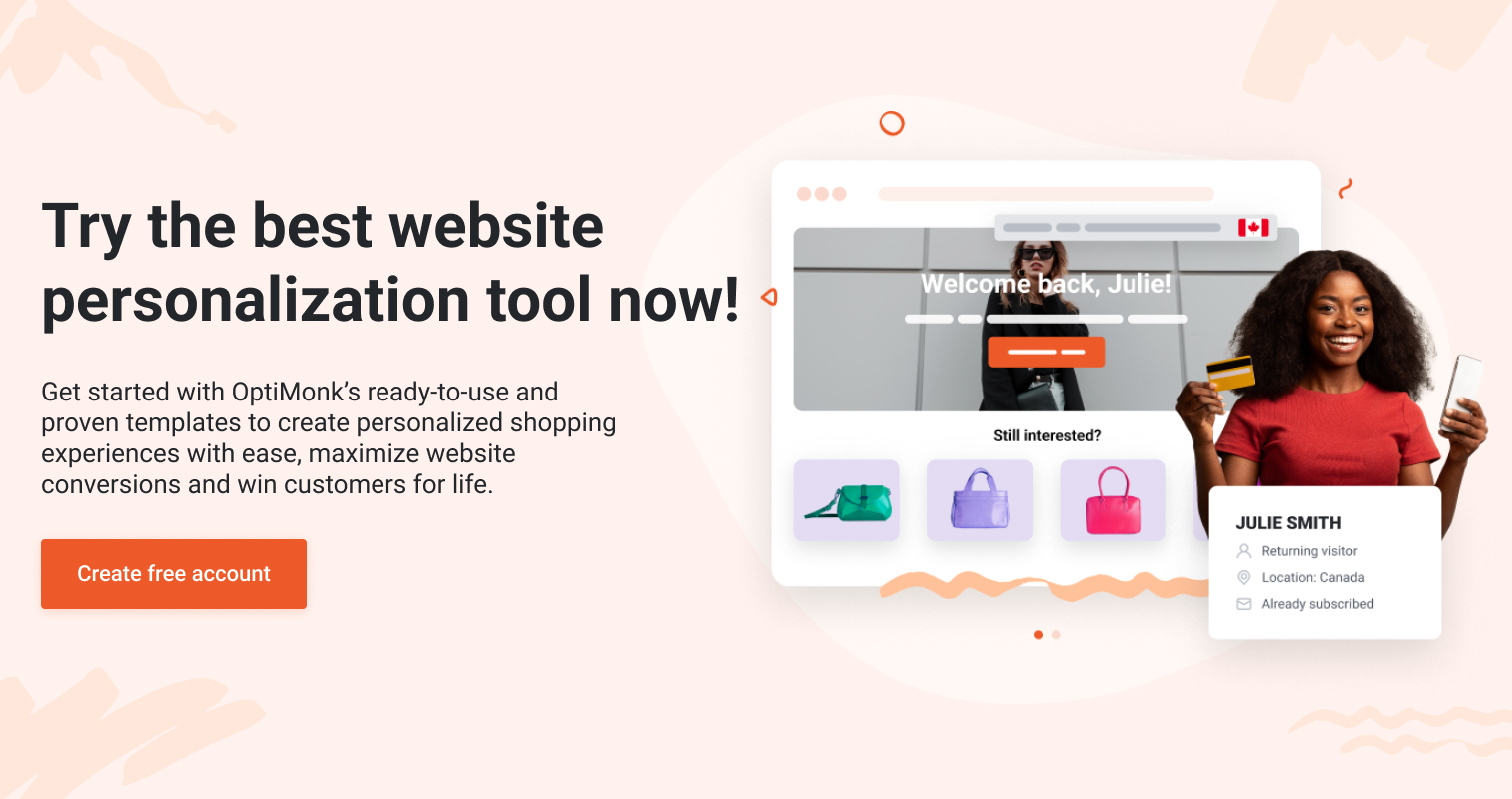- Blog
- Website Optimization: Techniques, Tools, and an Easy-to-Follow Checklist
Website Optimization: Techniques, Tools, and an Easy-to-Follow Checklist
-
Nikolett Lorincz
- Conversion
- 6 min read
Table of Contents
Did you know that you only have three seconds to make an impression on your website visitors?
As an ecommerce store, your potential customers will form a picture of your brand within the first few moments of visiting your website. Talk about pressure!
Optimizing your website is essential for ensuring its maximum performance. It can significantly improve both search engine rankings and the user experience, leading to better visibility and increased customer conversion.
In this article, we’ll cover exactly what website optimization is and explain how you should optimize your website to leave a lasting impression on your visitors.
Let’s dive in!
What is website optimization?
Website optimization is the process of improving the performance of a website in several different ways in order to:
- rank higher in SERP (search engine results pages),
- drive more traffic,
- improve the user experience, and
- increase conversions.
Typical web optimization efforts include conversion rate optimization (CRO), website personalization, search engine optimization (SEO), website speed optimization, navigation optimization, copywriting, and UX design.
Since there’s so much involved, it’s crucial to have a website optimization strategy, so you know which parts of your website you’re going to prioritize and which you’ll leave for later.
Why is website optimization important?
Web optimization will deliver many different benefits, both for your website users and your business.
First of all, website optimization can improve the user experience by boosting your page’s loading speed and providing a more user-friendly site structure. When your website visitors don’t have to wait around for your site to load, you’ll see more visitor engagement and increased time spent on site.
Furthermore, when you improve your site speed, you’ll also likely be improving your ranking in organic search results. That’s because search engines track site performance (through Google’s PageSpeed Insights algorithm, for example) to determine the quality and relevance of a site.
And when your site becomes more visible in user searches, you’ll get more traffic. Of course, that’s why SEO website optimization is such an important part of the process.
Finally, website optimization helps you maximize the conversions you generate from all your traffic. A well-optimized site will generate more conversions and sales, as visitors will be more likely to make a purchase from a site that’s quick, easy to use, and user friendly.
What's the best way to optimize your website?
As mentioned, website optimization is actually a collection of many different strategies or tactics. While there’s some overlap, these tactics generally have different purposes and are intended to improve different aspects of your website.
For instance, SEO website optimization strategies—like aligning content with the right keywords—help drive more organic traffic to a site, while conversion rate optimization and website personalization are intended to generate conversions from the website traffic you already have.
UX optimization, on the other hand, is all about improving the user experience and convincing visitors to spend more time on your website.
Just like there are many “ingredients” that go into website optimization, there are a huge number of different website optimization strategies that you could use.
When developing yours, it’s essential to consider your main goal.
The best way to figure out what you should focus on when starting to optimize your website is by running a customer journey analysis. That will tell you what the biggest problems are with your website, which are the things you should focus on first.
One important rule of thumb is that you shouldn’t chase after more traffic until you’ve made sure you’re getting the most out of the traffic you already have. After all, if you’re having trouble with your conversion rate, more traffic won’t fix the problems that are causing it. That’s why we suggest focusing on conversion rate optimization and website personalization first.
Both strategies are focused on increasing conversion rates (in fact, website personalization is a kind of CRO strategy).
The difference between them is that CRO is more focused on short-term boosts to conversion rates and uses tactics like increasing the urgency with countdown timers and offering discounts to every single visitor.
Website personalization, on the other hand, is about increasing conversions by creating an individually tailored user experience for each visitor. It relies on the clever use of customer data to adapt a website based on individual needs, preferences, and behavior.
6 website optimization examples
Now, let’s check out six strategies that can help you optimize your website for more conversions.
1. A/B test your headlines to drive more conversions
Whenever you create messages for your target audience, you should always evaluate how your content resonates with them.
The best way to do this is by A/B testing different versions of your web pages to see which versions of your headlines lead to the best conversion rate.
In the example below, an ecommerce store tested two different versions of the headline for a product page. One of them is strictly focused on the product’s features, while the other one includes the product’s unique selling point (USP) as well.

Without A/B testing these different variants, it’s almost impossible to know which one will lead to better results.
When you’re looking for website optimization tools, you want to ensure that they offer robust A/B testing and analytics features. Otherwise, it’ll be much harder to be sure that the web optimization steps you’re taking are actually improving your user experience and website performance.
(Bonus tip: Headlines are also important for your website’s SEO and ranking in search results, so make sure they contain relevant keywords!)
2. Personalize messages based on country
One important aspect of website personalization (and, therefore, website optimization as well) is getting your visitors the information they need without forcing them to go looking for it.
Since we know that shoppers are always concerned with shipping policies, it helps to inform them about whether you ship to their country and how much it costs.
To make the user experience even more convenient, you can show location-specific shipping information and special offers based on where users are browsing from.
This is a great example of using personalization to improve site structure, since customers won’t have to navigate to a specific web page to find your shipping policies for their country— that crucial info is delivered straight to them!

3. Personalize landing page headlines and content based on Facebook ad copy
Another on-page optimization tactic is adapting your site based on the ad that a user clicked on.
What this does is create a smoother customer journey because it keeps the user intent in mind— remember, the user wants to see products and content that correspond to the ad they just clicked on!
Aligning content ensures a seamless transition and enhances the overall user experience.
For example, if a user clicked on an ad that highlights a store’s selection of, say, engagement rings, they’ll be annoyed if the landing page they arrive on is showing necklaces or something else.
Once again, you can always optimize your website further by A/B testing different versions of these landing page welcome messages.
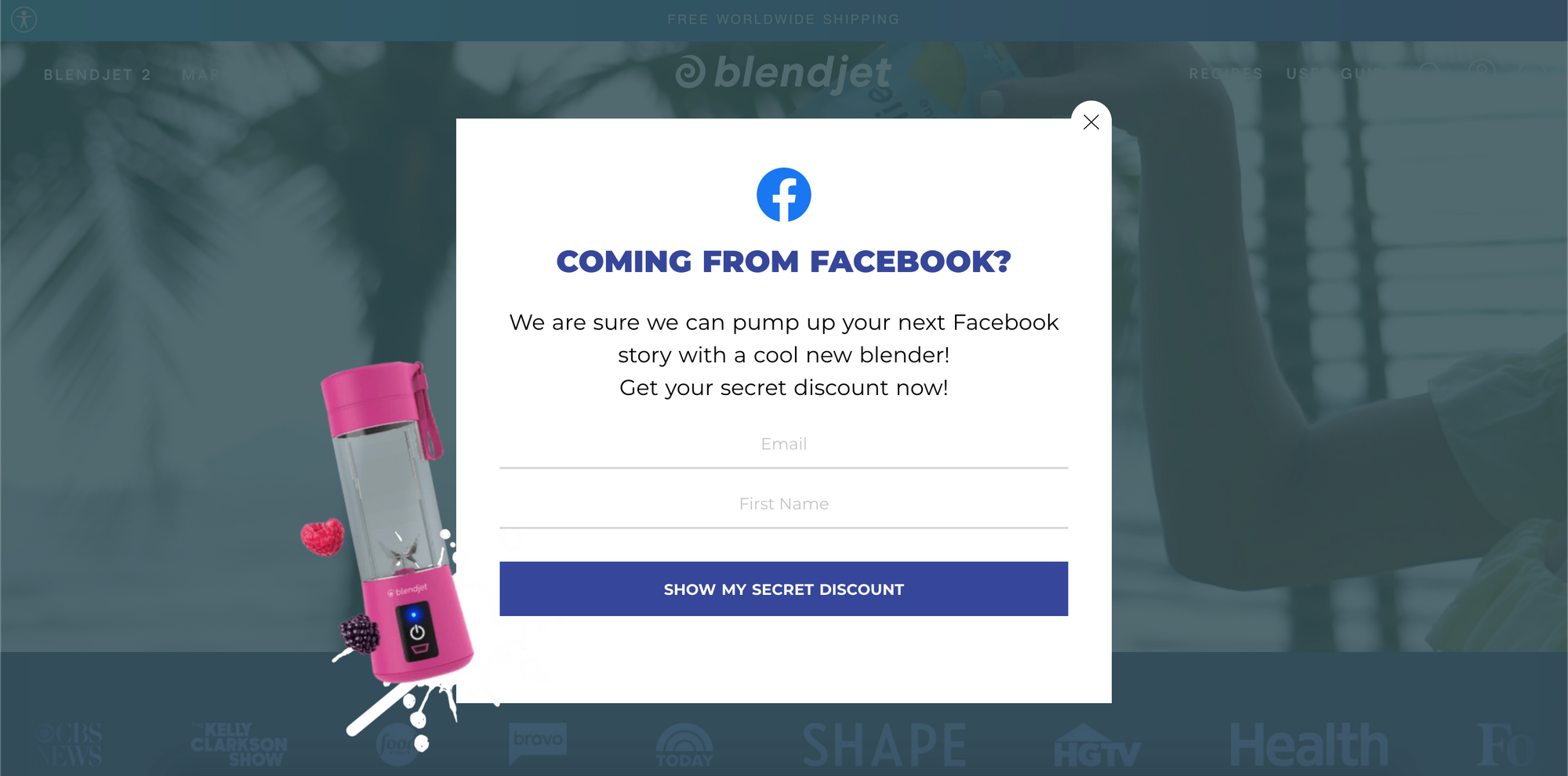
4. Show relevant product recommendations
Similar to the last tip, showing relevant product recommendations to your customers helps create a smooth customer journey. Instead of being shown all kinds of products and offers, the user experience stays focused on what each individual is actually interested in.
Amazon has been the king of delivering relevant product recommendations for years. In the example below, they offer products that are “Related to items you’ve viewed,” ensuring that the products they’re recommending are responsive to the interests of each customer.
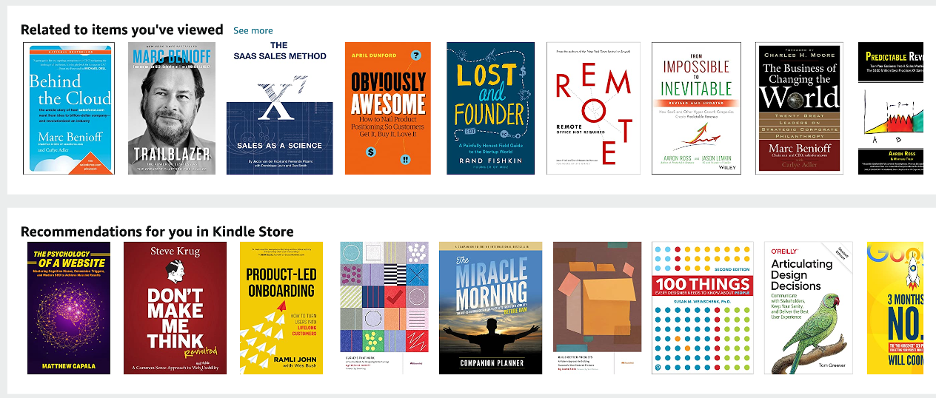
Also, if you’re concerned about your average order value and would like to increase it, you can use cross-selling and upselling.
Displaying bundles (like in the example below) or complementary products to what a user has added to their cart is an excellent sales strategy.
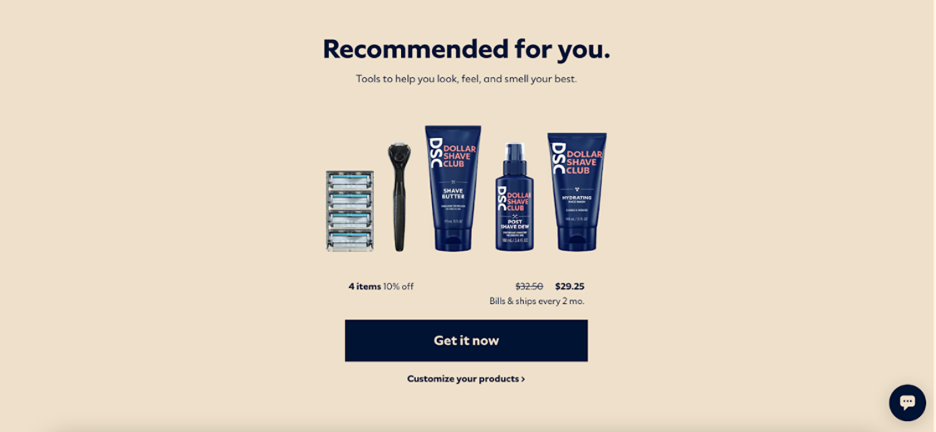
5. Implement cart abandonment campaigns
When a website visitor has been all the way through your sales funnel and placed one or more items in their cart, it’s a big deal when they abandon your site without completing their purchase.
And it tends to happen a lot— the average rate of cart abandonment is 66.5%! Since each abandoned cart you recover is a sale, this is a great target for website optimization.
Many website optimization tools can track current user behavior in order to know when a visitor is just about to exit a web page (both on desktop and mobile devices). This is a great time to offer a discount, since many of these customers just need one final incentive to actually make a purchase.
And if you use limited-time discounts like in the example below, you can create a sense of urgency that encourages users to make a purchase now rather than later.

6. Display social proof to build trust and improve conversions
Social proof is especially important to first-time buyers because they don’t have any experience with your products. Seeing what others have said about your brand can really help this segment decide to make a purchase.
The example below does a great job of highlighting positive customer reviews with both star ratings and written reviews.

5 search engine optimization strategies
As mentioned before, website optimization is not just about conversion rate optimization. Mastering search engine optimization (SEO) is also crucial for any website’s success.
In this section, we’ll take a look at five easy-to-implement search engine optimization strategies that can help optimize your website effectively.
1. Do keyword research
Conduct thorough keyword research to identify the terms and phrases your target audience is using to search for content related to your website.
Integrate these keywords strategically into your website’s content, including titles, headings, meta descriptions, and body text.
However, avoid overstuffing keywords, as this can lead to penalties from search engines.
2. Create quality content
High-quality, relevant content not only engages visitors but also signals to search engines that your ecommerce website is valuable and authoritative.
Regularly publish informative, well-written content that addresses the needs and interests of your target audience.
Incorporate multimedia elements such as images, videos, and infographics to enhance user experience and encourage sharing.
3. Optimize meta tags and descriptions
Meta tags, including title tags and meta descriptions, play a crucial role in informing search engines about the content of your web pages.
Craft compelling, concise titles and descriptions that accurately represent the content on each page while enticing users to click through from the SERPs.
Use relevant keywords naturally within these tags to improve visibility.
4. Optimize for mobile
With an increasing number of users accessing the internet via mobile devices, optimizing your website for mobile is essential for SEO success.
Ensure your website content is responsive and mobile-friendly, providing a seamless browsing experience across different screen sizes and devices.
Mobile optimization not only improves user satisfaction but also enhances your site’s visibility in mobile search results.
6 website speed optimization techniques
Improving your website’s speed is also crucial for user experience and SEO. A faster site reduces bounce rates and improves user satisfaction, leading to better rankings.
Here are some techniques to optimize your website speed:
1. Optimize images
Large image files are a common cause of slow load times.
Compress your images to reduce their file size without sacrificing quality. Formats like WebP are more efficient than traditional formats like JPEG or PNG, providing the same quality with smaller file sizes.
Additionally, consider using responsive images that adjust to different screen sizes.
2. Enable browser caching
Browser caching allows your website’s static files—such as HTML, CSS, JavaScript, and images—to be stored in a visitor’s browser.
When users revisit your site, the browser can load these cached files instead of downloading them again. This significantly reduces load times, especially for returning visitors.
To implement this, configure your server settings to define how long files should be cached.
3. Minify CSS, JavaScript, and HTML
Code files often contain unnecessary characters like spaces, line breaks, and comments, which increase their size and slow down your site. Minifying these files involves removing these unnecessary elements, making the files smaller and quicker to load.
Tools like UglifyJS for JavaScript or CSSNano for CSS can automate this process.
4. Use a Content Delivery Network (CDN)
A CDN distributes your website’s content across multiple servers in different geographical locations. When a user accesses your site, the CDN delivers content from the server closest to them, reducing latency and speeding up load times.
CDNs are particularly effective for global websites where users access the site from various parts of the world.
5. Reduce server response time
The time it takes for your server to respond to a user request—known as server response time—can significantly impact your site’s page speed.
You can reduce server response time by choosing a reliable hosting provider, optimizing your database, and minimizing the number of HTTP requests your site makes.
Regular server maintenance and updates are also crucial for maintaining optimal performance.
6. Implement lazy loading
Lazy loading is a technique in which images and videos are loaded only when they are about to enter the viewport rather than all at once when the page loads. This reduces the initial load time, especially for pages with a lot of media content.
By deferring the loading of offscreen content, you can improve perceived load times and reduce bandwidth usage.
Top 5 website optimization tools that work
Still with us? Great!
Let’s take a quick look at the best website optimization tools that you can use in 2024 (and beyond).
Each of these tools can help you improve different aspects of your site performance.
1. OptiMonk
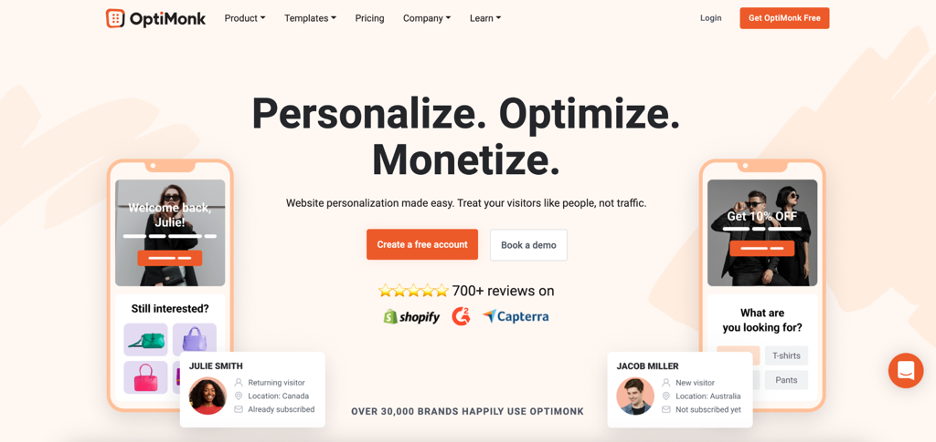
OptiMonk is a powerful website optimization and personalization platform that can help you improve your user experience, increase your conversion rates, and win loyal customers.
With OptiMonk’s personalization features, you’ll be able to easily find segments of users who have the same needs, preferences, and interests. Then, you can create personalized messages for each target audience, ensuring they resonate. Best of all, adding personalized sections to your site won’t reduce your website speed or cause flickering.
OptiMonk’s user-friendly and feature-packed integrations with a wide range of popular CMS and email marketing tools (like Klaviyo) mean you can put your customer data to use across different marketing channels.
Let’s take a quick look at some of OptiMonk’s key website optimization features.
Key feature #1: Embedded content
The new embedded content system enables you to adapt the user experience on your key pages for each individual customer. For example, you could add a personalized section that changes based on which of your ads a visitor clicked on (just like in tip #3 above). Best of all, embedded content is so easy to create using OptiMonk that you won’t need to write a single line of code!
Key feature #2: Product recommendations
OptiMonk’s personalized product recommendations are quick to set up but incredibly effective at displaying the products your visitors want to see. By picking up on user intent through tracking on-site behavior, OptiMonk’s recommendations will boost engagement rates and increase revenue.
Key feature #3: Experiments
Tracking the performance and optimizing the campaigns you create is crucial in website optimization. OptiMonk’s experiments feature allows you to go beyond simple A/B testing, giving you the ability to test as many variants of your campaigns as you want.
Additional benefits:
- Drag-and-drop editor makes designing campaigns a breeze
- Place embedded content using an intuitive point & click tool
- Audience insights identify the right segments to show messages to
- Advanced campaign analytics give you an understanding of how much revenue your campaigns are bringing in
- Smart tags help you take advantage of the first- and zero-party customer data you’ve collected
- Use a variety of overlays (like popups, side messages, sticky bars, and full screens) to display content
Pricing:
You can start with a free account today.
2. Hotjar
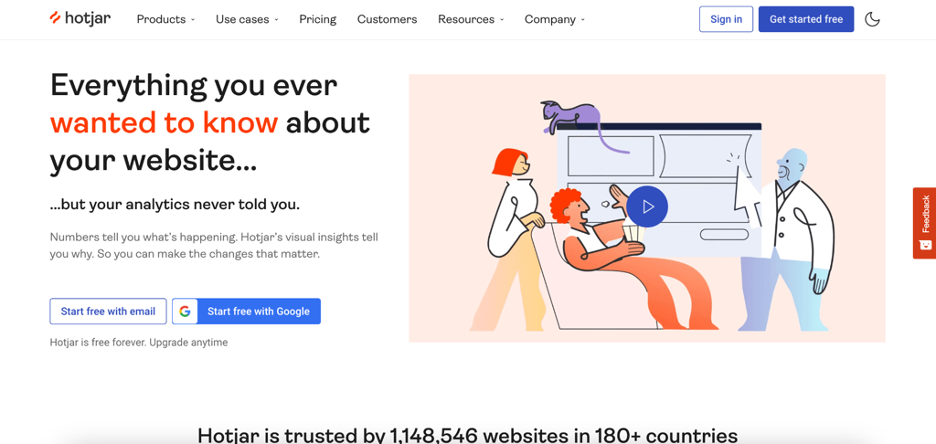
Hotjar is an incredibly useful tool for understanding how visitors are interacting with your web pages (and where you tend to lose the most conversions).
Using mouse-tracking technology to track every visitor’s movements throughout each session, Hotjar shows site owners where visitors fly through the marketing funnel and where they’re getting confused.
This means that Hotjar can help you plan out your website optimization priorities by identifying where improvements need to be made.
Pricing:
The basic version is free, but premium plans can unlock more features.
3. Google PageSpeed Insights
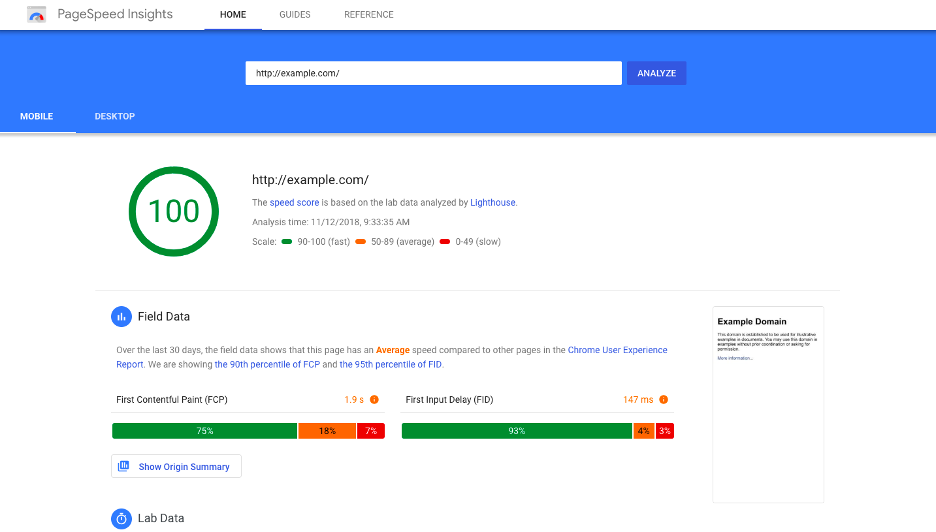
PageSpeed Insights, from Google, helps you evaluate your website loading speed quickly and easily.
All you have to do is type in your URL and Google will not only tell you how quickly your website loads, but also how you can improve your page speed. For example, if large media files are slowing things down, this optimization tool will let you know.
One great aspect of PageSpeed Insights is the fact that it tests your website speed for both desktop and mobile users. After all, when you’re optimizing your website, you want to make sure it performs well on any device your visitors are using.
Pricing:
PageSpeed Insights is a free tool.
4. Google Optimize
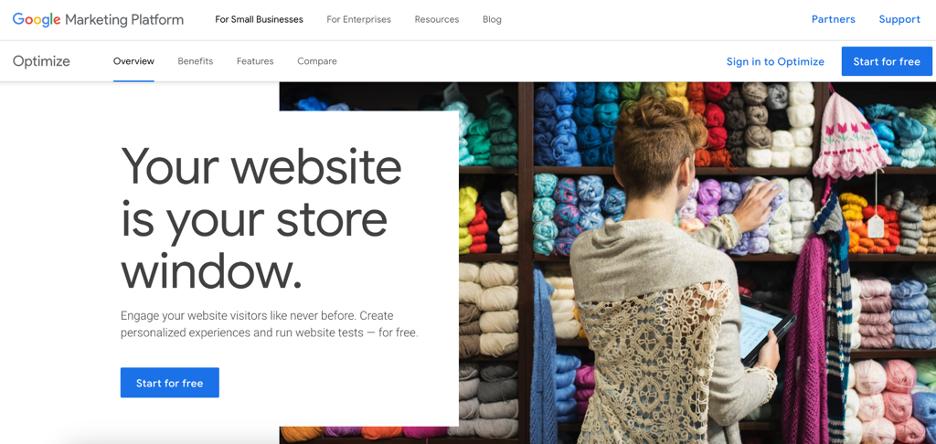
Google Optimize is a conversion optimization tool that helps you find ways to improve your site through its A/B testing and analytics capabilities. You can compare many different versions of your site to see which one performs best.
Since Optimize integrates with Google Analytics and other Google tools, you can get a lot of insights about your site’s performance that are backed up by hard data.
Pricing:
Optimize is free to use. There’s also an enterprise version, Optimize 360.
5. SurferSEO
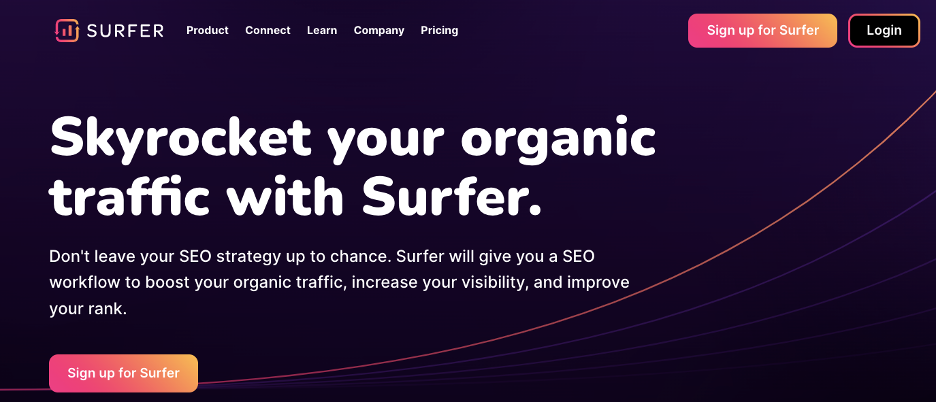
SurferSEO is an essential tool for your SEO efforts, allowing you to perform keyword research, write content that will rank on search engines, and keep track of quality backlinks and external links.
When you write quality content in Surfer, you’ll be able to see a score that reflects how well-optimized your content is for your search keywords. And once you outperform competitors’ sites in the search results, you’ll start capturing tons of organic traffic.
Pricing:
Basic plan starts at $49/month.
Website optimization checklist
Ready to dive into the website optimization process? Here’s a handy checklist to guide you through each essential step:
1. Speed optimization
- Compress images (e.g., WebP format)
- Enable browser caching
- Minify CSS, JavaScript, and HTML
- Use a Content Delivery Network (CDN)
- Reduce server response time
- Implement lazy loading
2. Conversion rate optimization
- A/B test headlines and CTAs
- Personalize messages based on location
- Display relevant product recommendations
- Implement cart abandonment campaigns
- Showcase social proof (e.g., reviews)
3. Search engine optimization
- Conduct keyword research
- Optimize meta tags and descriptions
- Create high-quality, relevant content
- Ensure mobile responsiveness
4. User experience
- Simplify navigation
- Use clear and descriptive labels
- Optimize forms for usability
- Implement responsive design across devices
5. Technical optimization
- Set up and regularly update an XML sitemap
- Implement HTTPS for security
- Fix broken links and resolve crawl errors
6. Personalization
- Tailor landing page content to match ad copy
- Use embedded content for dynamic user experiences
Regularly reviewing this checklist containing website optimization tips will help you maintain a user-friendly, high-performing, and optimized website.
FAQ
What are the different types of website optimization?
Website optimization encompasses various strategies and techniques aimed at improving a website’s performance, user experience, and visibility. Some of these are performance optimization, mobile optimization, conversion rate optimization, and content optimization.
How can you optimize a website for search engines?
Here are some key steps to optimize a website for search engines:
- Identify relevant keywords and phrases that your target audience is using to search for content related to your website.
- Focus on on-page SEO and optimize elements such as titles, headings, meta descriptions, and URLs with targeted keywords to make it easier for search engines to understand and index your content.
- Publish high-quality, informative content that provides value to your audience and encourages engagement and sharing.
- Ensure that your website is responsive and mobile-friendly to provide a seamless browsing experience for mobile users.
- Earn high-quality backlinks from authoritative and relevant websites to signal to search engines that your site is trustworthy and deserving of higher rankings.
- Address technical SEO issues such as broken links, crawl errors, XML sitemap optimization, and website structure to improve indexing and crawling by search engines.
Final thoughts
Website optimization can seem overwhelming, but when you break it down into smaller tasks based on your goal, it’s more than manageable! And you’ll see lots of benefits from any effort you put into optimizing your website.
OptiMonk is a comprehensive personalization platform that’s quite simply one of the best website optimization tools on the market today. Take full advantage of user insights to personalize your landing pages, homepage, and product pages, creating a unique customer journey for each of your customers.
And thanks to OptiMonk’s cutting-edge tech, adding personalized elements won’t compromise your website speed or hurt your position in the search results.
If you’re interested in following up on any of these optimization tips, you can create a free account with OptiMonk today!
Migration has never been easier
We made switching a no-brainer with our free, white-glove onboarding service so you can get started in the blink of an eye.

What should you do next?
Thanks for reading till the end. Here are 4 ways we can help you grow your business:
Boost conversions with proven use cases
Explore our Use Case Library, filled with actionable personalization examples and step-by-step guides to unlock your website's full potential. Check out Use Case Library
Create a free OptiMonk account
Create a free OptiMonk account and easily get started with popups and conversion rate optimization. Get OptiMonk free
Get advice from a CRO expert
Schedule a personalized discovery call with one of our experts to explore how OptiMonk can help you grow your business. Book a demo
Join our weekly newsletter
Real CRO insights & marketing tips. No fluff. Straight to your inbox. Subscribe now
Nikolett Lorincz
- Posted in
- Conversion
Partner with us
- © OptiMonk. All rights reserved!
- Terms of Use
- Privacy Policy
- Cookie Policy
Product updates: January Release 2025









